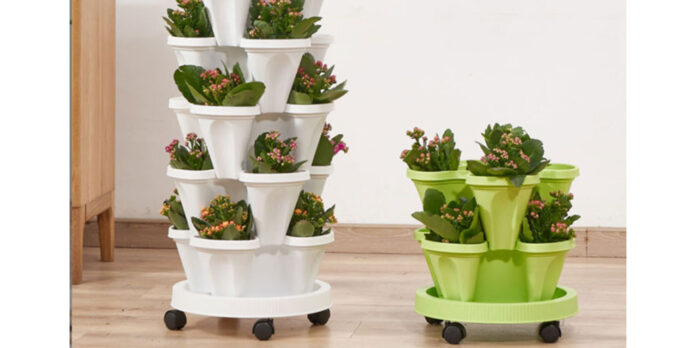For many years now, vertical gardening has been an effective solution for modern farming in little spaces. With zero to no room, you can use a stackable planter for your mini garden, saving space while allowing you to farm multiple plants. Stackable planters are best suited for growing vegetables, herbs, and flowers, which can be categorized to develop simultaneously.
Combining stackable planters to form a self-watering system is a game-changer for your indoor or small outdoor garden. As a gardener, you should always devise new ways to reduce inconvenience while maximizing the benefits. A self-watering stackable planter is highly functional and supplies water to the plants even after a long period. This property makes it easy to reap benefits with little to no effort put into the plants.
How Does A Self-Watering Stackable Planter Work?
The stackable part of the planter has a straightforward design. A typical one has four stacked layers. The bottom part has a central hole and smaller ones used for draining. A small distance from the bottom of the layer, there is an internal plate. The plate is the path through which water passes into the drainage and central hole. This bottom part has a tray attached to it, and a chain is passed through the central hole through which the second layer is connected.
Usually, plants are watered from the top, but scientifically water absorption occurs at the bottom. The self-watering aspect, therefore, requires simple knowledge. Water reservoirs are placed at the bottom of the stackable planter, and watering occurs through capillary action. The roots absorb water and transport it to the rest of the plant hence the name self-watering. The reservoirs require constant refilling to function correctly.
Important Features
Although it might seem like this method may cause the oversaturation of water, there is an overflow hole element that drains the water if it accumulates. This element is vital for your plant to survive without experiencing root rot.
How Do You Use Them?
These types of planters come in two types. One is the removable water reservoir, while the other has attached tubes. Your work is to refill the water containers and plant tubes when the water capacity significantly reduces. A standard refilling is done every three weeks, although it can vary depending on the season or type of plant.
Benefits of Using Stackable Self-Watering Planters
1. Pest Control
Overwatering is one of the causes of pest infestation. These systems work perfectly to prevent root rot, which keeps the pests away.
2. Less Watering Work
Your workload is significantly reduced since the plant and system do all the watering work for you. Refilling is the only job you have to do to ensure the plant is self-sustained.
3. Increased Plant Consistency
Moisture levels in the plant are always balanced; hence the plant’s growth becomes more consistent. The balance ensures that the plant grows very healthy and succulent.
Conclusion
A self-watering stackable planter is a sustainable system to ensure proper plant growth while minimizing space. Not all plants, however, should use this method as they don’t have extended roots to carry out the self-watering process. Stackable planters are an excellent way to start small-scale gardening, which can significantly benefit you. Many vegetables and flowers thrive in vertical gardening; hence can be a commercial side hustle for you.







